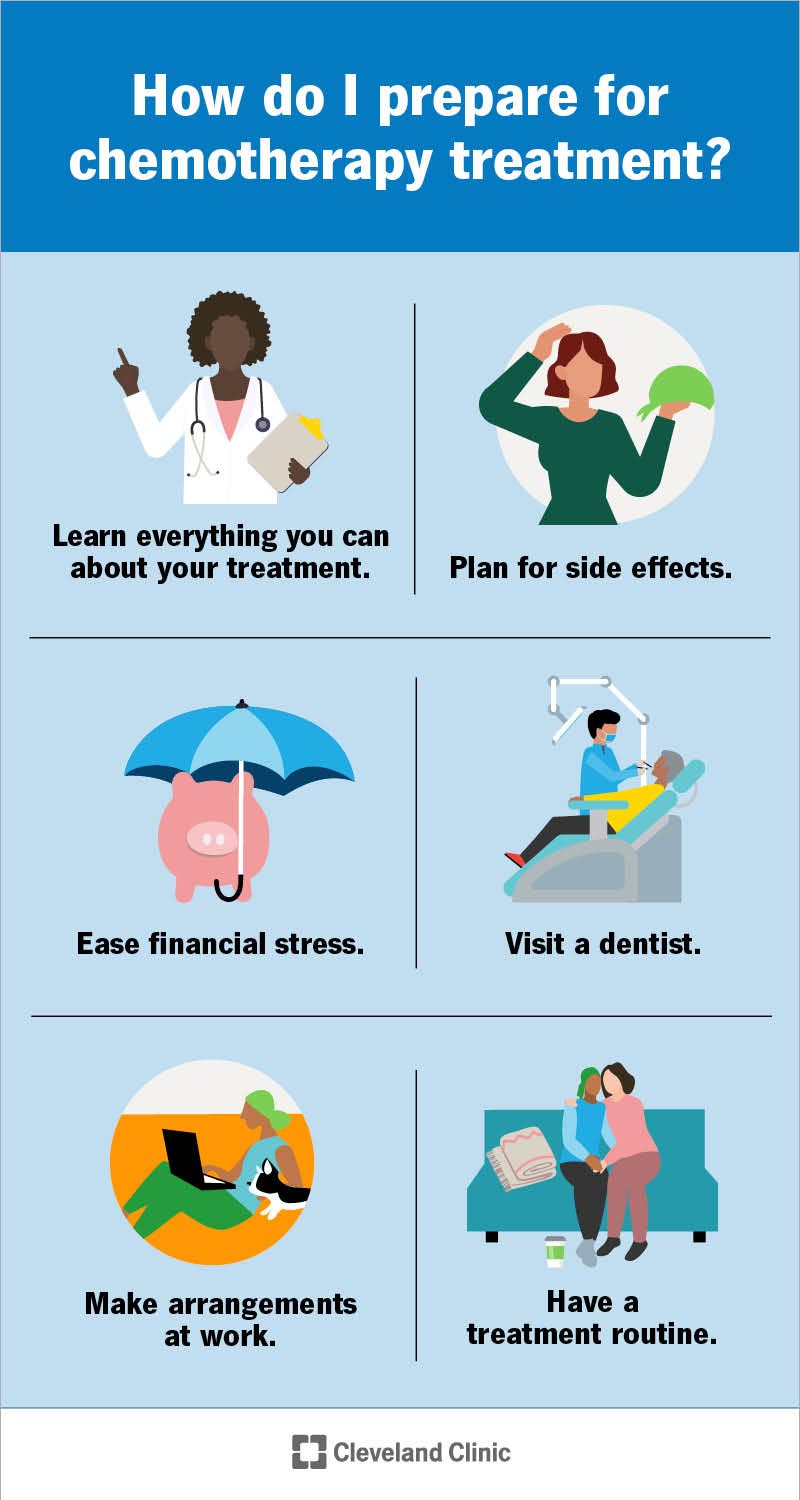Chemotherapy is a common cancer treatment. It uses drugs to destroy cancer cells and prevent tumor growth. It may be paired with other cancer treatments such as radiation therapy or surgery. Chemotherapy is usually given intravenously (through a vein). It’s an effective treatment but can cause side effects.
Advertisement
Cleveland Clinic is a non-profit academic medical center. Advertising on our site helps support our mission. We do not endorse non-Cleveland Clinic products or services. Policy
Chemotherapy is a type of cancer treatment. Also called “chemo,” it’s one of several cancer treatments that use drugs against various types of cancer. Other drug therapies include:
Advertisement
Cleveland Clinic is a non-profit academic medical center. Advertising on our site helps support our mission. We do not endorse non-Cleveland Clinic products or services. Policy
A medical oncologist oversees treatment. These healthcare providers specialize in chemotherapy and other cancer-fighting drugs.
Chemotherapy may get used with surgery or radiation therapy to treat cancer.
Cancer cells grow and divide uncontrollably. Chemotherapy destroys the cancer cells and prevents them from multiplying.
Your oncologist may use chemotherapy in different ways:
Chemotherapy can treat a wide range of cancers, including:
Advertisement
The type of chemotherapy you receive depends on several factors:

Your oncologist will ensure you’re healthy enough for treatment by running tests. In the meantime, you can take steps to prepare for chemo.
Your experience depends on how your oncologist will administer your chemotherapy drug treatments.
Chemotherapy is usually systemic, meaning the chemotherapy drug travels throughout your entire body. You may receive systemic chemo:
Some cancers don’t respond well to systemic chemotherapy. In certain cases, you might need chemotherapy delivered to a specific area of your body. Examples include:
The most common way to give chemotherapy is intravenously, through an IV. Chemotherapy can go directly into a vein through a:
Advertisement
Catheters and ports are helpful if you need multiple rounds of chemotherapy. They avoid the need for constant needle sticks in your arm. Your oncologist may also use catheters and ports to deliver other medications. These may include antibiotics or antiemetics (medications to prevent nausea and vomiting).
The length of chemotherapy treatment depends on the type of chemo you receive. A treatment session can take anywhere from a few minutes to a few hours. Some people need a continuous infusion, which can last several days. A continuous infusion might start at the hospital or infusion center and continue at home.
Most people need multiple rounds of chemotherapy. A single round of chemotherapy may involve treatment for several days or weeks, followed by a period with no chemotherapy. This time off allows your body time to recover from treatment. Afterward, you may receive another chemotherapy round following the same on-off pattern.
You may receive daily, weekly or monthly treatments.
Chemotherapy treatments are typically outpatient procedures, which means you can go home that same day. You may receive treatment:
Advertisement
Chemotherapy drugs target all fast-growing cells, including cancer cells. This means chemotherapy drugs destroy cancer cells but can also damage other cells in your body, potentially causing side effects. Blood cells and the cells in your skin, hair follicles and digestive tract are examples of cells that grow and multiply quickly. That’s why some common side effects of chemotherapy occur in these areas, including:
Talk to your care team about ways to manage the side effects of cancer treatment.
Despite the potential side effects, chemotherapy has been an effective, reliable cancer treatment for decades. Chemo can rid your body of cancer completely, or it can help you have a better quality of life by reducing symptoms. Chemotherapy can also make other treatments, such as surgery or radiation therapy, more effective.
Many side effects of chemotherapy will go away after you stop treatment. Some effects of chemotherapy, though, may not show up until months or years after treatment. Late effects of chemo can include:
Advertisement
Many people find cancer rehabilitation helpful in managing the effects of cancer treatment.
Cancer can come back after chemotherapy or any type of cancer treatment. Once treatment ends, your care team often asks you to come for follow-up visits to check for disease. Your oncologist may recommend more cycles of chemotherapy to treat cancer that returns.
There isn’t a specific cancer stage when people receive chemotherapy treatments. The type of chemotherapy drugs you receive, the dose and timing of treatment depend on multiple factors. For example, you may have cancer that responds to chemotherapy as a first-line treatment. Or your oncologist may recommend chemotherapy only after other treatments haven’t worked.
Ask your oncologist about the best treatment approach for your specific situation.
Most people don’t experience pain during treatment sessions, especially if they’re taking pills or using a topical cream. If you’re receiving a shot or injection, you may feel an uncomfortable sting or prick when the needle goes in. You may feel slight burning once the medicine enters your body, but the sensation usually lessens during treatment.
Yes. Some forms of cancer are sensitive to chemotherapy and go away completely following treatment. Healthcare providers take care when using words like “cure” when it comes to cancer because there’s always a chance it could return. Still, many cancer survivors are currently cancer-free thanks to chemotherapy.
Chemotherapy is one of the most common types of cancer treatment. Chemotherapy can work on its own or be paired with other treatments like radiation therapy, surgery or other drug therapies. The type of chemotherapy you receive will depend on your cancer’s stage and location, as well as your overall health. Chemotherapy may cause side effects in the short term and long term. Before starting any cancer treatment, talk to your healthcare provider about the risks and benefits.
When you’re diagnosed with cancer, you want expert and compassionate care right away. At Cleveland Clinic we personalize your treatment to match your needs.

Last reviewed on 10/20/2022.
Learn more about the Health Library and our editorial process.